Inductive reasoning skills are crucial to many positions in the job market as they allow individuals to observe unfamiliar concepts, detect underlying problems, and reach a logical decision. Therefore, a top goal of hiring companies is to pick out candidates who can spot patterns and think laterally.
With the above need of recruiters, inductive reasoning tests have been introduced as a comprehensive tool to measure candidates’ ability to deal with abstract problems and interpret underlying rules. This article will give you a deeper insight into the tests, with a clear understanding of each question type and how to nail them.
Table of Contents
What are inductive reasoning tests?
Inductive reasoning tests are a common type of aptitude test, often requiring you to identify and interpret patterns of shapes or figures.The tests often last 15-20 minutes, including around 20-30 questions. Some common test providers of inductive reasoning tests are SHL, Aon, or Saville.
Inductive reasoning tests are becoming popular in the pre-hiring process as effective screening tools to measure candidates’ abstract reasoning and problem-solving skills, specifically the ability to work with unfamiliar concepts.
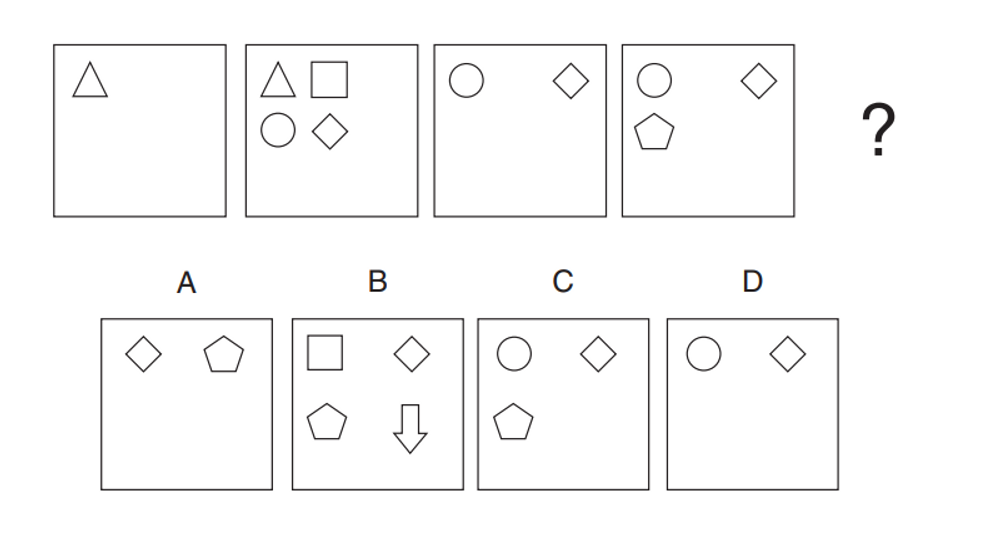
Source: “How to pass diagrammatic reasoning tests” by Mike Bryon
- Figure Series: Determine the missing figure in a sequence of items.
- Odd One Out: Spot the figure different from other items.
- Matrix: Find the missing tile or fragment of a matrix.
Along with deductive reasoning, inductive reasoning tests are often categorized as logical thinking in aptitude tests. Both types measure your ability to apply logic in problem-solving and use reasoning skills to arrive at a rational conclusion. Depending on the demand of each role, logical reasoning tests can come in the form of Inductive and/or Deductive to assess relevant qualities for the jobs.
Inductive reasoning vs. Deductive reasoning
Though both types of aptitude tests aim to assess logical thinking ability, inductive reasoning and deductive reasoning are different in the logic area each type focuses on. Below is a table comparing these 2 domains of logical reasoning:
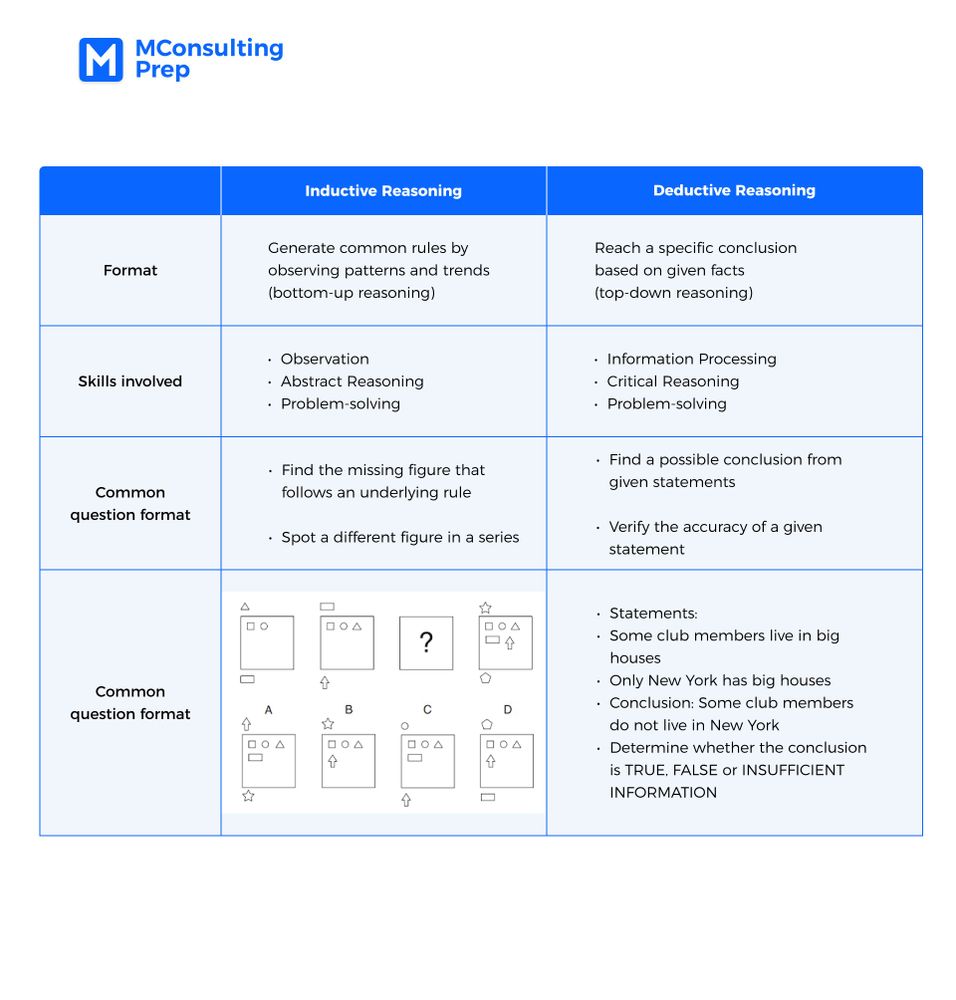
Common questions in inductive reasoning tests
Inductive reasoning questions can vary in format and difficulty; however, you may encounter 3 main types of problems in an inductive reasoning test: Figure Series, Odd One Out, and Matrix.
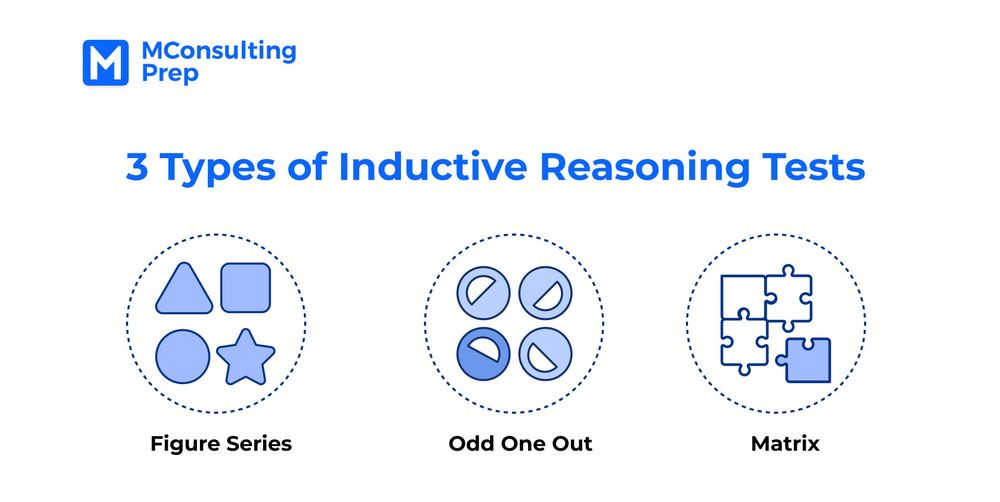
The next part of this article will show you the typical question format of each type and some helpful tips to ace the tests.
Figure series
In Figure Series, you will be asked to find the next figure in a sequence. To do so, you must identify the underlying rule governing the series. Let’s take a look at an example of this question type:
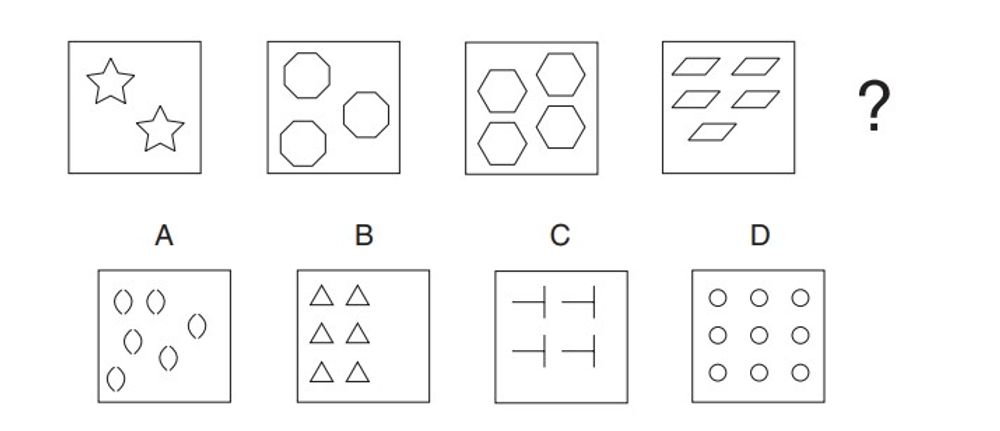
Source: “How to pass diagrammatic reasoning tests” by Mike Bryon
Answer: A
Explanation:
Rule 1: The number of shapes in a figure increases by 1 after one step.
Rule 2: The number of sides in each shape decreases by 2 after one step.
KEY TAKEAWAYS: To figure out the pattern in a series, there are some details in the figures you can look for:
- The rotation of figures (both individual or whole)
- The change in colors or positions
- The reflection of shapes and figures
- The increase or decrease in the number of figures
Let’s apply these helpful tips to solve other sample questions below:
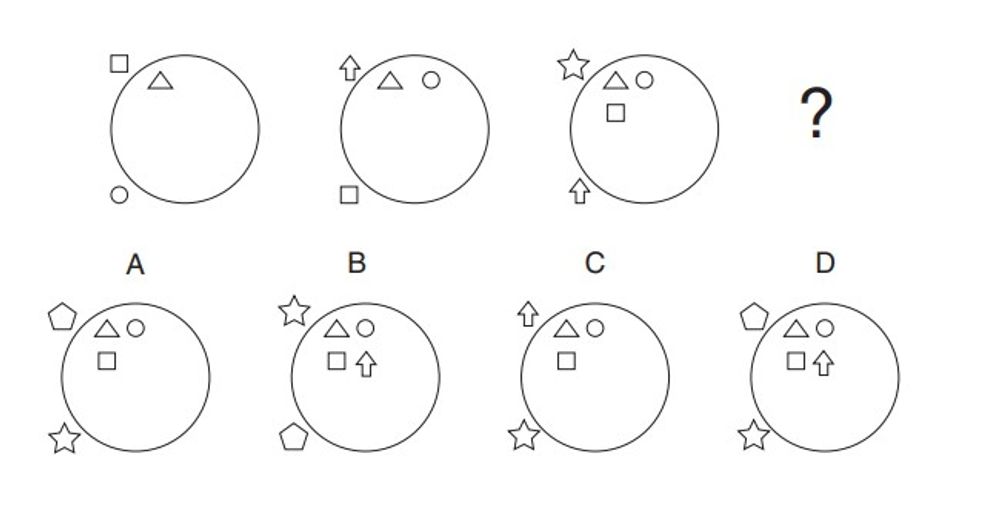
Source: “How to pass diagrammatic reasoning tests” by Mike Bryon
Answer: D
Explanation:
The below shape outside moves into the circle in the next step, while the shape above moves down.
Despite the guidelines listed above, practicing as many questions as possible is crucial to master the skills for inductive reasoning tests. With enough practice, you can recognize common patterns and save time when taking actual exams.
Fortunately, MConsultingPrep is here to provide hundreds of inductive reasoning practice questions, ranging in type and level, to help you sharpen your skills. There are also practical study guides for each logic category (rotation, movement, etc.) to nail every question in the exam!
Odd one out
Odd One Out question gives you a number of figures, from which you have to identify the one different from the remaining shapes. Therefore, it is important to spot the common pattern of given items to see which figure doesn’t follow the governing rule. Here are some sample questions for you to practice.
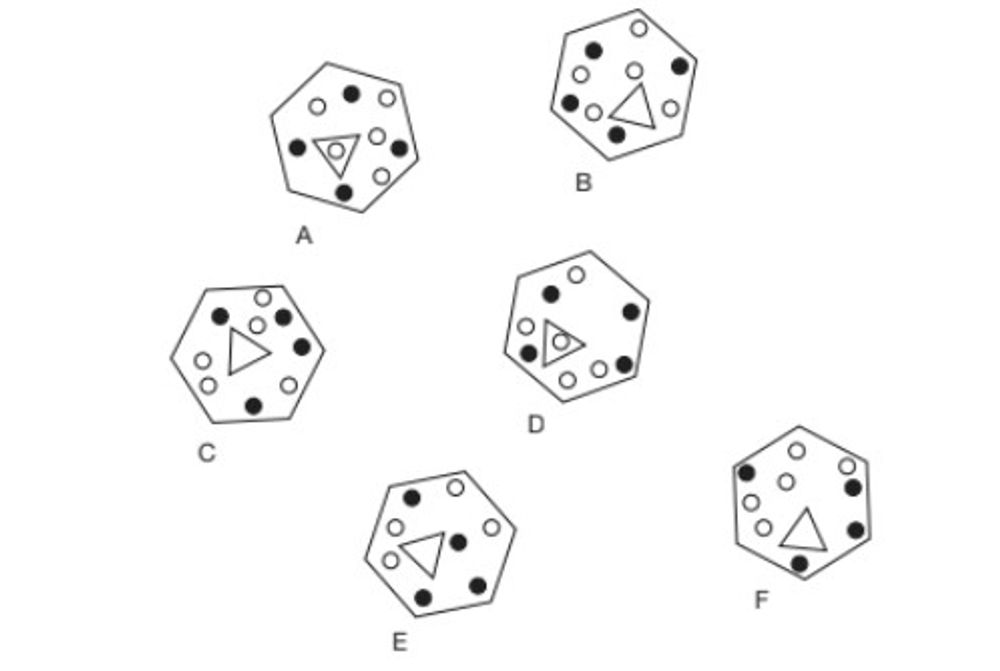
Source: “The Ultimate IQ Test Book” by Philip Carter & Ken Russell
Answer: E
Explanation:
Figure E contains 4 white circles, while the rest contains 5.
Let’s challenge yourself with another Odd One Out question.
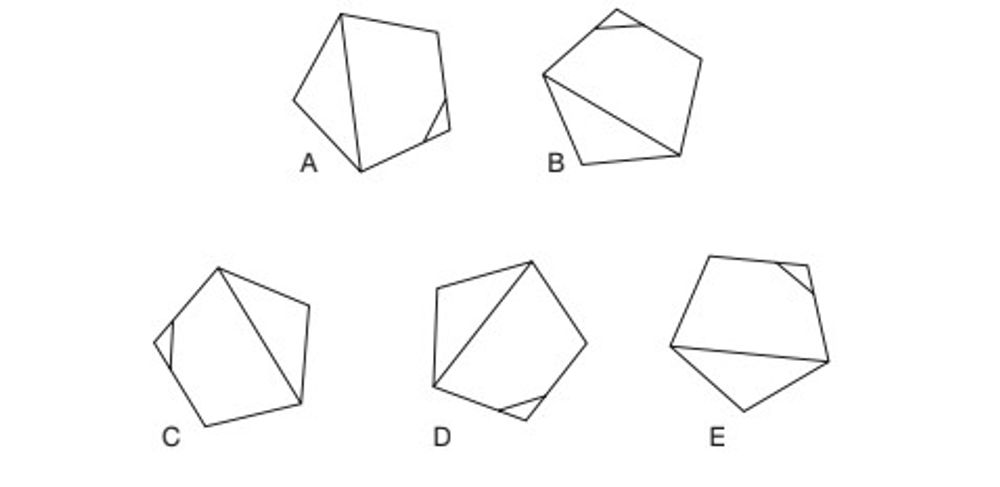
Source: “The Ultimate IQ Test Book” by Philip Carter & Ken Russell
Answer: B
Explanation: Option A, C, D, and E are the same figure rotated. The small triangle at the bottom of the pentagon in figure B is on the right, while that of the remaining figures is on the left.
Besides fluid intelligence, it is crucial to sharpen your detection skills. You can practice error-checking exercises or lively Spot-the-Difference games to enhance your ability. Remember that practice makes perfect; it is one proven way to pass the tests.
Matrix
You will be given a grid of items, which requires you to find the missing part based on given patterns. This question type is among the most taxing in inductive reasoning tests, but luckily, it rarely appears in the screening assessment stage of most companies. Let’s try out an example to see how good your abstract reasoning skills are.

Source: “The Ultimate IQ Test Book” by Philip Carter & Ken Russell
Answer: D
Example: The last two rows of figures repeat the first two rows of figures in reverse order.
Common inductive reasoning test providers
Though assessing the same skills, inductive reasoning tests from different test publishers often vary in format, difficulty level, and time limit. The majority of test providers have this test type in their assessments, including the most common publishers: SHL, Saville, Aon, Korn Ferry, and Cubiks. Let’s look at the inductive reasoning tests of each producer to see their differences.
SHL
SHL inductive reasoning questions come in different formats, such as completing a sequence or matrix. The tests typically take you 25 minutes to complete 24 questions. Here is an example of an SHL inductive reasoning question.
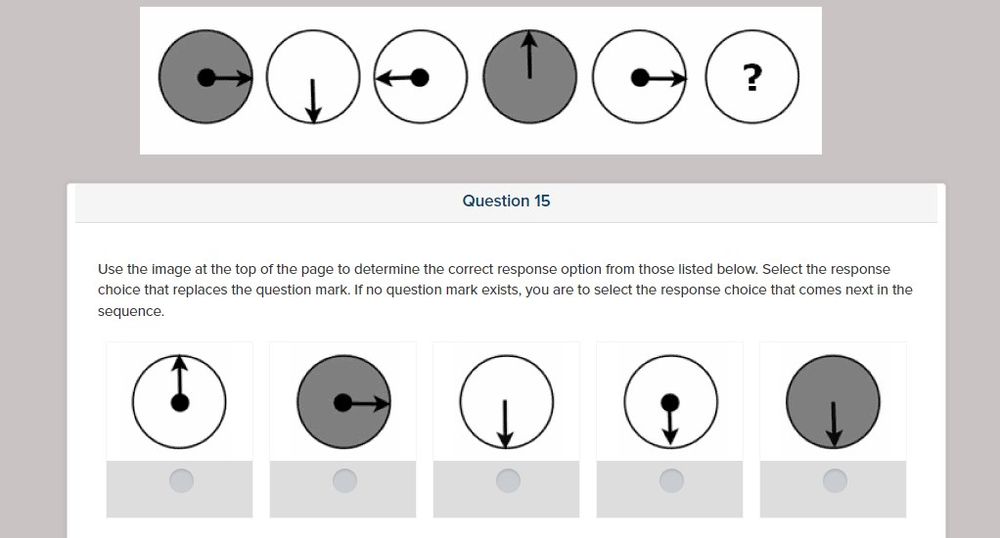
Source: SHL
Answer: C
Explanation:
Rule 1: The shaded background occurs after every 2 steps.
Rule 2: The centered black round appears in 1st, 3rd, 5th,... positions.
Rule 3: The arrow moves clockwise.
SHL inductive reasoning tests also come in another format: SHL Verify Interactive, which requires candidates to work interactively on the screen by dragging or dropping objects. Here is a sample interface of this question format:
Source: SHL Interactive
Saville
Saville inductive reasoning tests, often known as abstract reasoning tests, contain questions asking you to find a missing figure of a sequence or matrix. The completion time is 16 minutes, and you must finish as many questions as possible. Let’s look at how Saville's question will be:
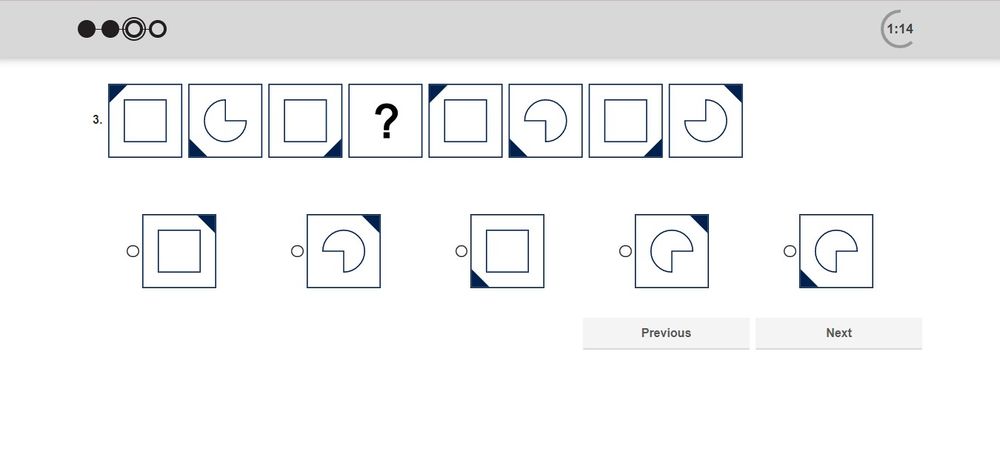
Source: Saville
Answer: D
Explanation:
Rule 1: The small triangle in the corner moves counterclockwise.
Rule 2: The square occurs in 1st, 3rd, 5th, 7th,... positions, while the “pacman” shape in 2nd, 4th, 6th,...
Rule 3: The “pacman” shape rotates 90 degrees clockwise in every step.
Aon
Aon inductive reasoning questions (or logical reasoning questions) require you to identify the underlying rules behind 2 sets of tables and assign colors to 4 additional items. There will be 12 questions to complete within 12 minutes. To understand this question type better, you can look at this example:
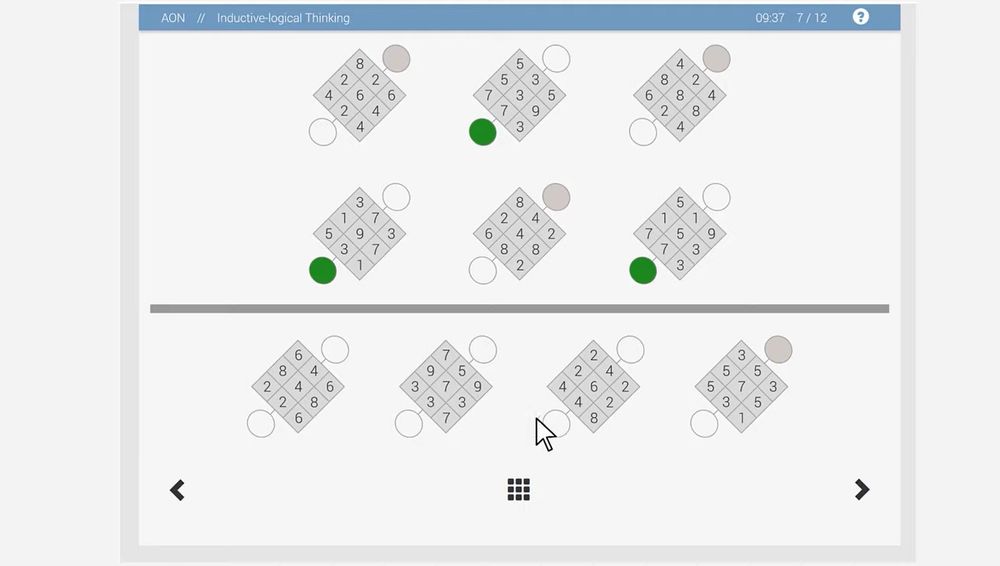
Source: Aon
Answer: Gray-Green-Gray-Green
Explanation: Gray tables contain even numbers, while odd numbers are in green tables.
Korn Ferry
Korn Ferry (Talent Q) inductive reasoning questions contain a 3x3 matrix with different shapes and symbols, from which you have to determine the missing tile. You will have 15 minutes to complete 12 questions. Below is how a Korn Ferry inductive reasoning question looks like:
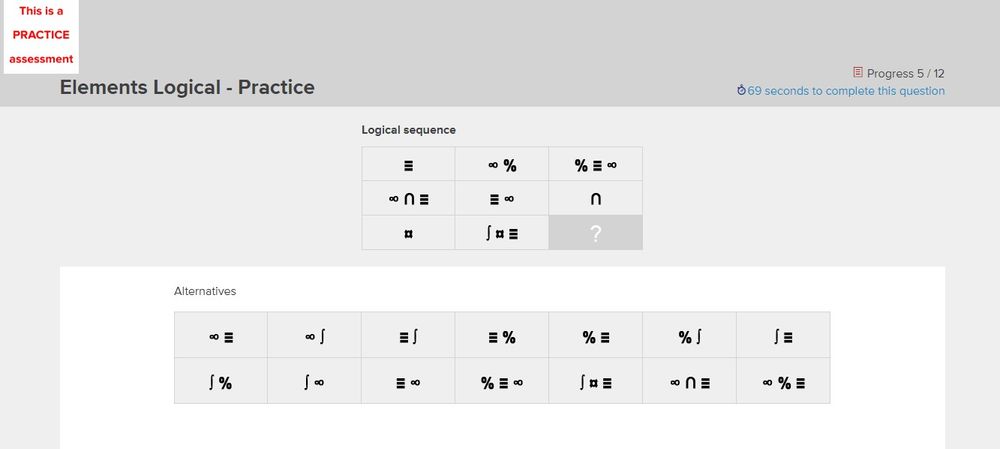
Source: Korn Ferry (Talent Q)
Answer: The 3rd option in the upper row.
Explanation: In a row, the single item will move to the center of the 3-item box, while 2 items on the sides switch positions.
Cubiks
In Cubiks inductive reasoning questions (also known as Logiks Abstract) ask you to identify the common pattern of given items, then select the option that follows the same rule. There are 30 questions under a time limit of 15 minutes. Here is an example for you to practice:
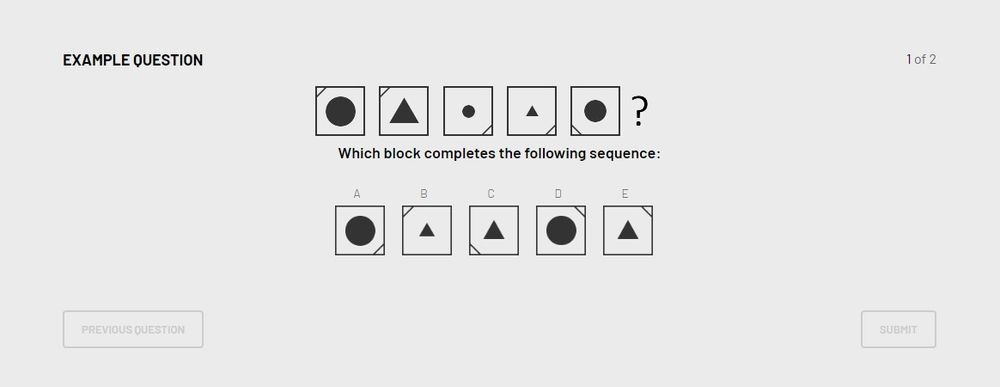
Source: Cubiks
Answer: C
Explanation:
Rule 1: The size of each shape alternates from large, small to medium.
Rule 2: Each size has a corresponding location of the small triangle.
Large - top left corner
Small - lower right corner
Medium - lower left corner
How to pass inductive reasoning tests
Working with unfamiliar and abstract concepts can be challenging as it requires an amount of natural intelligence rather than accumulated industry knowledge. However, you can follow these helpful tips to enhance your skills for inductive reasoning tests.
Analyze the alteration of each figure
In an inductive reasoning question, there will be various figures or shapes, each of which follows a specific pattern. Therefore, it is very complicated to figure out all the rules simultaneously. Focus on the pattern of the objects one by one, and if necessary, write down each rule to avoid confusion. To better demonstrate this tip, let’s examine the sample question below:
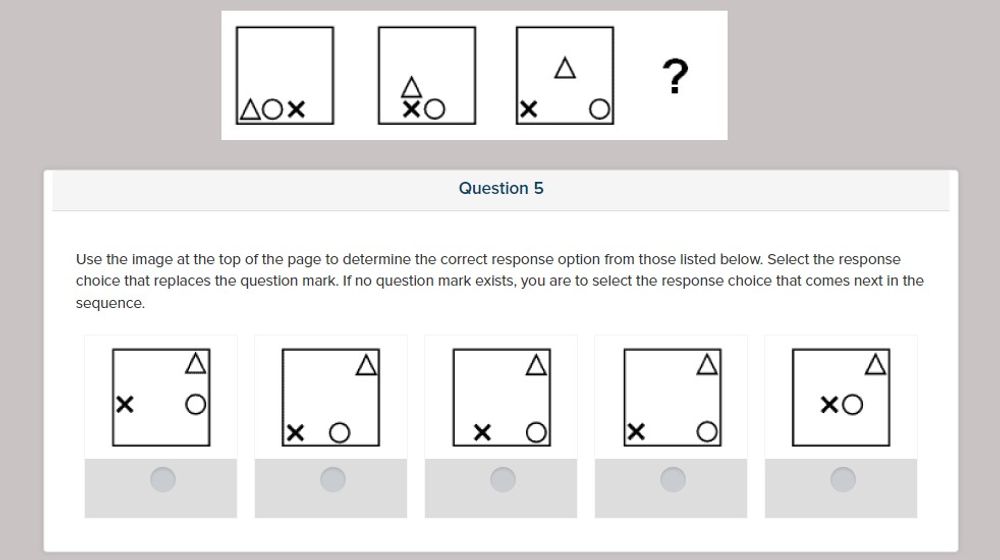
Source: SHL
Answer: A
Explanation:
Rule 1: The triangle moves diagonally upwards.
Rule 2: The circle moves one step clockwise.
Rule 3: The X moves one step anticlockwise.
At first, the question can look mentally taxing as there are many symbols moving disorderly. However, when you break down each figure in a box and follow their movements one by one, the problem becomes much easier.
Make an educated guess
This tip can assist the first advice when you cannot figure out the underlying patterns of all objects. In that case, eliminate options that do not contain the rules you have spotted previously. Let’s try another example to apply this tip:
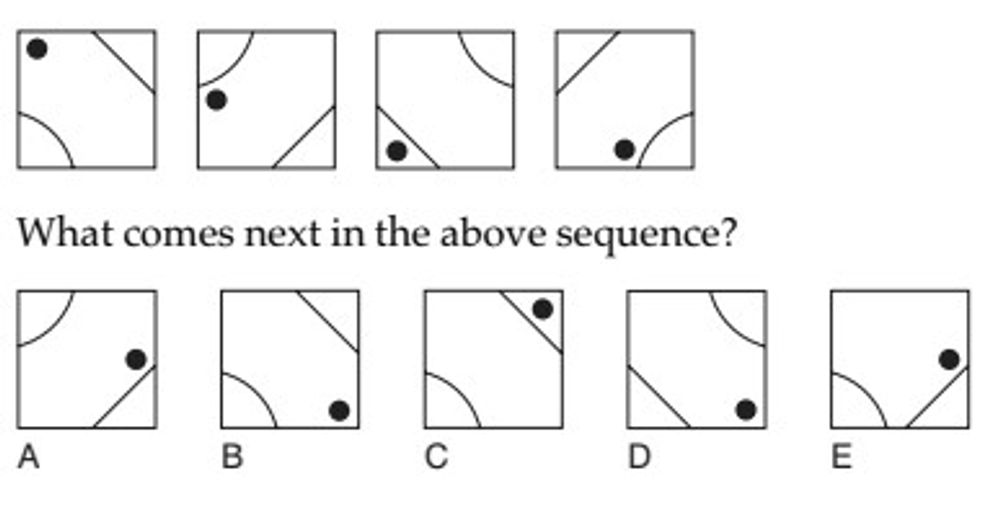
Source: “The Ultimate IQ Test Book” by Philip Carter & Ken Russell
Answer: B
Explanation:
Rule 1: The black dot moves one step anticlockwise.
Rule 2: The triangle moves one step clockwise.
Rule 3: The quarter of a circle moves one step clockwise.
Following the previous example, the black dot moves one step counterclockwise. Therefore, you can easily eliminate A, C, and E. Now, the problem has become much simpler as you have to examine only 2 options.
Practice sample questions regularly
As mentioned above, you likely encounter some common patterns in inductive reasoning tTests, including rotation, movement, changes in quality, swapping, or symmetry. To identify these underlying patterns quickly under a tight time limit of the actual test, you need to practice common questions from test publishers, test books, or simulation platforms like MConsultingPrep. Practicing is undoubtedly a proven way to master any aptitude test regardless of any tip and trick, so throw yourself into as many exercises as you can!
Frequently asked questions
1. Which positions require inductive reasoning tests?
Inductive Reasoning Tests are used for jobs that involve working with patterns, such as engineering, science, IT, or technical design. Inductive Reasoning Tests also measure logical thinking and frequent problem-solving ability, so you will likely take these assessments when applying for business managerial positions.
2. How long does an inductive reasoning test take on average?
A full-length Inductive Reasoning Test typically takes you around 15-20 minutes. The completion time varies depending on each test publisher's purpose and difficulty level, so you can take their practice tests to familiarize yourself with various time duration.
3. Why are inductive reasoning tests so hard?
Inductive Reasoning Tests have become a tough ask for many candidates worldwide as the problem is presented in abstract figures and symbols, which challenges any prior industry knowledge. Another difficulty comes from the strictly-timed test duration, only 30-60 seconds for a question on average.
/filters:quality(75)//case_thumb/public/1699589977462_aptitude_tests_package_4_x.png)